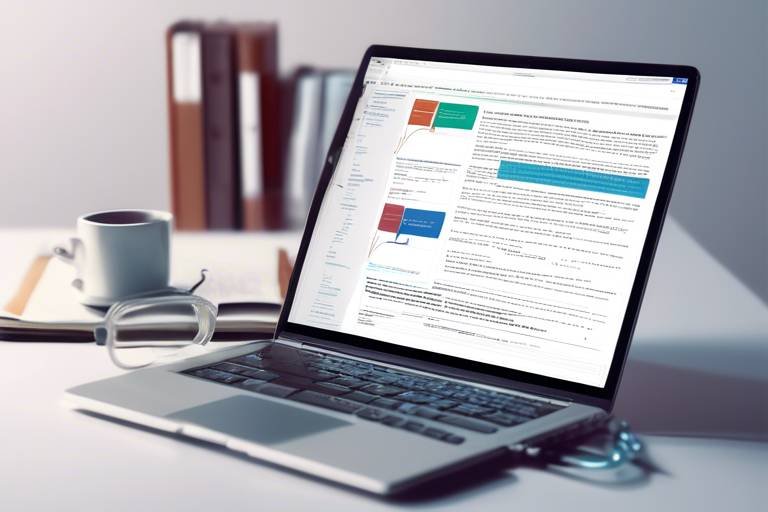The Benefits of Using Action Research in Educational Settings
Action research has become a transformative approach in educational environments, offering a plethora of advantages that can significantly enhance teaching practices and student experiences. At its core, action research is a reflective process where educators systematically inquire into their own teaching methods and the learning outcomes of their students. This iterative cycle of planning, acting, observing, and reflecting not only empowers teachers but also creates a vibrant atmosphere of continuous improvement and innovation in schools. By actively engaging in this process, educators can uncover insights that lead to better instructional strategies, improved student engagement, and overall professional development.
One of the most compelling benefits of action research is its ability to enhance teacher effectiveness. When teachers reflect on their practices, they become more aware of their strengths and areas for improvement. This self-awareness is crucial as it leads to the development of more effective instructional strategies that can positively impact student learning. Furthermore, action research fosters a culture of collaboration within educational institutions, allowing teachers to work together to share insights and best practices. This collaborative spirit not only enriches the teaching experience but also builds a supportive community where educators feel valued and motivated.
In addition to benefiting teachers, action research plays a pivotal role in boosting student engagement. By involving students in the research process, educators can create a more interactive and responsive classroom environment. Students feel empowered when their voices are heard, and their feedback is taken into account. This involvement fosters a sense of ownership over their learning journey, making them more motivated and engaged. For instance, when teachers gather feedback on specific lessons or projects, they can tailor their approaches to better meet students' interests and needs, creating a more personalized learning experience.
Action research empowers teachers to reflect on their practices, leading to improved instructional strategies and better student outcomes. It encourages continuous professional growth and fosters a culture of collaboration within educational institutions.
By involving students in the research process, action research enhances their engagement and motivation. It allows educators to tailor learning experiences that resonate with students' interests and needs, fostering a more interactive classroom environment.
Gathering and analyzing student feedback is a crucial component of action research. This practice helps teachers understand students' perspectives, enabling them to make informed adjustments to their teaching methods and curriculum. For example, a teacher might find that students are struggling with a particular concept. By soliciting feedback, they can identify the specific areas of confusion and adjust their instructional strategies accordingly.
Action research facilitates the development of a responsive curriculum that adapts to the evolving needs of students. This flexibility ensures that educational content remains relevant and engaging, ultimately enhancing learning experiences. A curriculum that evolves based on student feedback and performance data is more likely to capture students' interests and keep them engaged in their learning journey.
Through action research, educators can experiment with and evaluate new teaching strategies. This innovative approach encourages risk-taking and creativity, allowing teachers to discover effective methods that improve student learning outcomes. For instance, a teacher may try out project-based learning in one class and compare the results with traditional teaching methods in another class. This hands-on experimentation can yield valuable insights into what works best for their students.
Action research promotes collaboration among educators, creating learning communities where teachers share experiences and insights. This collective approach fosters a supportive environment that enhances professional development and shared best practices. When educators come together to discuss their findings and strategies, they not only grow individually but also contribute to the overall improvement of the educational institution.
The implementation of action research can positively influence school culture by promoting a sense of ownership and accountability among educators. This collaborative effort cultivates an environment of trust, respect, and continuous improvement. When teachers feel empowered to take initiative and lead research projects, they contribute to a culture where innovation and growth are valued.
Action research provides opportunities for educators to take on leadership roles within their schools. By leading research initiatives, teachers can develop essential leadership skills that benefit both their professional growth and the school community. This not only enhances their careers but also inspires others to engage in similar pursuits, creating a ripple effect of leadership development throughout the institution.
Utilizing data in action research allows educators to make informed decisions based on evidence. This data-driven approach enhances the effectiveness of teaching practices and contributes to the overall success of educational programs. By analyzing student performance data, teachers can identify trends, measure the impact of their interventions, and continuously refine their teaching methods to better serve their students.
- What is action research? Action research is a reflective practice where educators systematically inquire into their teaching methods and student learning outcomes to improve their effectiveness.
- How does action research benefit students? It increases student engagement by involving them in the research process and allows educators to tailor learning experiences to their interests and needs.
- Can action research improve school culture? Yes, it promotes collaboration, trust, and accountability among educators, fostering a positive school culture focused on continuous improvement.
- What role does data play in action research? Data is essential in action research as it helps educators make informed decisions and evaluate the effectiveness of their teaching strategies.

Enhancing Teacher Effectiveness
Action research is a powerful tool that empowers teachers to become more effective in their roles. By engaging in this reflective practice, educators can critically examine their teaching methods and identify areas for improvement. This process is akin to a gardener tending to their plants; just as a gardener observes the growth and health of their garden, teachers can observe their students' learning and adapt their strategies accordingly.
One of the key benefits of action research is that it fosters a culture of continuous professional growth. When teachers commit to examining their practices, they not only enhance their own skills but also contribute to the overall improvement of their educational environment. This collaborative atmosphere encourages teachers to share insights and strategies, creating a supportive network that benefits everyone involved.
Moreover, action research encourages educators to implement evidence-based practices. By collecting data on student performance and engagement, teachers can make informed decisions that directly impact their instructional strategies. For instance, if a teacher notices that students are struggling with a particular concept, they can adjust their approach based on the data gathered. This cycle of observation, reflection, and adjustment is crucial for enhancing teacher effectiveness.
Additionally, action research promotes a sense of ownership among teachers regarding their professional development. When educators actively participate in the research process, they feel more invested in their growth and the success of their students. This sense of ownership can lead to increased motivation and job satisfaction, ultimately benefiting the entire school community.
To illustrate the impact of action research on teacher effectiveness, consider the following table that outlines key components and their corresponding benefits:
| Component | Benefits |
|---|---|
| Reflection | Encourages self-assessment and growth |
| Data Collection | Informs instructional strategies |
| Collaboration | Fosters a supportive learning environment |
| Ownership | Increases motivation and job satisfaction |
In conclusion, action research is not just a method; it’s a mindset that transforms the way educators approach their teaching. By embracing this practice, teachers can enhance their effectiveness, leading to better outcomes for students and a more vibrant educational community.
- What is action research? Action research is a reflective process where educators systematically examine their teaching practices to improve student learning.
- How does action research benefit teachers? It helps teachers identify strengths and weaknesses in their instructional strategies, promotes collaboration, and fosters professional growth.
- Can action research be applied in all educational settings? Yes, action research can be adapted to various educational contexts, making it a versatile tool for teachers everywhere.

Boosting Student Engagement
When it comes to education, student engagement can be the secret sauce that transforms a mundane classroom into a vibrant learning hub. Action research plays a pivotal role in this transformation by actively involving students in the research process. Imagine a classroom where students aren’t just passive recipients of information but are instead engaged participants in their own learning journey. This is the essence of action research, and it’s a game-changer!
By incorporating action research, educators can tailor their teaching methods to resonate with what truly interests their students. This means moving away from a one-size-fits-all approach and instead embracing a more personalized learning experience. For instance, when teachers gather insights about students' interests, they can adjust lesson plans to include topics that spark curiosity and excitement. This not only keeps students engaged but also fosters a deeper understanding of the material.
Moreover, when students see that their feedback is valued and taken into account, it builds a sense of ownership over their education. They feel empowered, knowing that they have a voice in shaping their learning experiences. This is where the magic happens! When students are engaged, they are more likely to participate actively in discussions, collaborate with peers, and take initiative in their learning. It’s like turning on a light bulb; suddenly, the classroom is filled with energy and enthusiasm.
To illustrate the impact of student engagement through action research, consider the following table that outlines the benefits:
| Benefit | Description |
|---|---|
| Increased Motivation | Students are more motivated to learn when they see their interests reflected in the curriculum. |
| Improved Learning Outcomes | Engaged students tend to perform better academically, as they are more invested in their learning. |
| Enhanced Collaboration | Action research encourages teamwork, allowing students to learn from one another. |
| Stronger Relationships | When students are engaged, they build stronger relationships with their peers and teachers. |
Additionally, action research opens the door for innovative teaching strategies that can further boost student engagement. Teachers can experiment with various methods and evaluate their effectiveness in real-time. For example, incorporating technology, project-based learning, or interactive activities can make lessons more dynamic and appealing. These strategies not only capture students' attention but also cater to diverse learning styles, ensuring that every student has the opportunity to thrive.
Ultimately, the goal of boosting student engagement through action research is to create a thriving educational environment where students feel excited about learning. When students are engaged, they are more likely to take ownership of their education, leading to a more fulfilling and successful academic experience. So, why not embrace action research and watch your classroom transform into a lively community of eager learners?
- What is action research?
Action research is a reflective process where educators systematically investigate their teaching practices to improve student learning outcomes. - How does action research enhance student engagement?
By involving students in the research process and tailoring lessons to their interests, action research fosters a sense of ownership and motivation. - Can action research be applied in all educational settings?
Yes, action research can be adapted to suit various educational contexts, from primary schools to higher education institutions.

Incorporating Student Feedback
One of the most significant aspects of action research is its emphasis on . This crucial element not only enhances the teaching process but also empowers students by giving them a voice in their education. Imagine walking into a classroom where students feel comfortable sharing their thoughts and opinions about what they are learning. This dynamic creates an atmosphere of trust and respect, where students are more likely to engage actively in their own learning journey.
By gathering and analyzing feedback from students, educators gain valuable insights into their perceptions and experiences. This practice can take various forms, such as surveys, focus groups, or informal conversations. For instance, a teacher might distribute a quick survey at the end of a unit to gauge students' understanding and enjoyment of the material. The responses can then be analyzed to identify patterns and areas for improvement, allowing educators to make informed adjustments to their teaching methods and curriculum.
The incorporation of student feedback not only allows teachers to tailor their instructional strategies but also fosters a sense of ownership among students. When students see that their opinions matter and lead to tangible changes in the classroom, they are more likely to feel invested in their learning. This investment can significantly boost motivation and engagement, creating a more vibrant and interactive classroom environment.
Furthermore, the feedback loop established through action research encourages ongoing dialogue between teachers and students. This continuous communication helps build stronger relationships and a more cohesive learning community. Teachers can ask specific questions to elicit targeted feedback, such as:
- What aspects of the lesson did you find most engaging?
- Were there any topics that you struggled to understand?
- How could I improve the learning experience for you?
By actively seeking out and valuing student input, educators can create a responsive curriculum that evolves with the needs of their students. This adaptability is essential in today’s fast-paced educational landscape, where student interests and societal demands are constantly shifting. Ultimately, the practice of incorporating student feedback not only enhances teaching effectiveness but also cultivates a culture of collaboration and continuous improvement within the classroom.
In summary, action research provides a structured approach for educators to integrate student feedback into their teaching practices. This process leads to a more engaging and relevant learning experience, fostering an environment where both students and teachers can thrive together. As we continue to explore the benefits of action research, it becomes clear that listening to students is not just beneficial; it’s essential for creating an enriching educational experience.
Q: How does student feedback impact teaching methods?
A: Student feedback provides educators with insights into what works and what doesn’t in their teaching methods, allowing them to make necessary adjustments for improved learning outcomes.
Q: What are some effective ways to gather student feedback?
A: Effective methods include surveys, focus groups, classroom discussions, and one-on-one conversations that encourage students to share their thoughts openly.
Q: Can incorporating student feedback really change the curriculum?
A: Yes, when educators actively listen to student feedback, they can adapt and modify the curriculum to better meet the interests and needs of their students, resulting in a more engaging learning experience.

Creating a Responsive Curriculum
In today's fast-paced educational landscape, creating a responsive curriculum is more important than ever. But what does it mean to be responsive? Simply put, it means being able to adapt and adjust the curriculum based on the needs, interests, and feedback of students. This approach not only keeps the learning experience relevant but also ensures that students remain engaged and motivated. Imagine a classroom where lessons are tailored to the interests of the students—where learning feels less like a chore and more like an adventure!
Action research plays a pivotal role in this process. By engaging in systematic inquiry, educators can gather valuable data on student performance and preferences. This data can then be analyzed to identify trends and areas for improvement. For instance, if teachers notice that students are struggling with a particular concept, they can modify their teaching strategies or materials to better address those challenges. This cycle of reflection and adjustment is what makes a curriculum truly responsive.
Moreover, a responsive curriculum fosters a sense of ownership among students. When learners see that their feedback is valued and acted upon, they are more likely to take an active role in their education. This can lead to increased participation and enthusiasm in the classroom. Teachers can create a feedback loop by:
- Conducting surveys to gauge student interests and learning preferences.
- Holding regular discussions to explore what students enjoy or find challenging.
- Incorporating student suggestions into lesson planning and curriculum design.
Additionally, a responsive curriculum is not static; it evolves over time. As new educational trends emerge and societal needs change, educators must be willing to rethink their approaches. This can involve integrating technology, embracing project-based learning, or even collaborating with community organizations to provide real-world experiences. The flexibility to pivot and innovate ensures that students are not just learning facts but are also developing critical thinking skills that will serve them well beyond the classroom.
In conclusion, creating a responsive curriculum through action research is a dynamic process that enriches the educational experience for both students and teachers. By continuously assessing and adjusting teaching methods and materials, educators can create a learning environment that is not only effective but also engaging and relevant. This approach ultimately leads to improved student outcomes and a more fulfilling teaching experience.
Q: What is action research?
A: Action research is a reflective process where educators systematically inquire into their teaching practices to improve student learning outcomes.
Q: How does a responsive curriculum benefit students?
A: A responsive curriculum addresses students' needs and interests, leading to increased engagement, motivation, and better learning experiences.
Q: Can all educators implement action research?
A: Yes! Action research can be implemented by educators at all levels, and it encourages collaboration and shared learning among teachers.
Q: What role does student feedback play in action research?
A: Student feedback is crucial in action research, as it provides insights into their experiences and helps educators make informed adjustments to their teaching methods.

Implementing Innovative Teaching Strategies
In the ever-evolving landscape of education, is not just a choice; it's a necessity. Action research serves as a powerful tool for educators to explore and experiment with new methods that can significantly enhance the learning experience. Imagine a classroom where traditional lectures are swapped for interactive discussions, where technology is seamlessly integrated into lessons, and where students are not just passive recipients of information but active participants in their own learning journey. This is the essence of innovation in teaching.
Through action research, teachers can embark on a journey of discovery, testing out various strategies and evaluating their effectiveness. For instance, a teacher might decide to incorporate project-based learning into their curriculum. By allowing students to work on real-world problems, they not only gain knowledge but also develop critical thinking and collaboration skills. This hands-on approach can lead to a deeper understanding of the subject matter and make learning more relevant and exciting.
Moreover, innovative teaching strategies can take many forms, such as:
- Flipped Classrooms: Students learn new content at home through videos or readings and engage in meaningful activities in class.
- Gamification: Incorporating game elements into lessons to increase motivation and engagement.
- Blended Learning: Combining traditional face-to-face instruction with online learning opportunities.
Each of these strategies encourages educators to think outside the box and develop a more dynamic learning environment. The beauty of action research lies in its cyclical nature—teachers can continuously refine their strategies based on feedback and results. This iterative process not only enhances their teaching practice but also fosters a culture of innovation within the school.
In addition, when teachers share their findings with colleagues, they contribute to a collaborative learning community where everyone benefits. Imagine a school where teachers regularly come together to discuss their action research projects, sharing successes and challenges alike. This exchange of ideas can spark further innovation and inspire others to try new approaches in their classrooms.
Ultimately, the goal of implementing innovative teaching strategies through action research is to create a more engaging and effective learning experience for students. As educators embrace this approach, they not only improve their own practices but also empower their students to take charge of their learning, making education a truly transformative experience.
- What is action research? Action research is a reflective process where educators systematically investigate their teaching practices to improve student learning outcomes.
- How can I start implementing action research in my classroom? Begin by identifying a specific area of your teaching that you want to improve, gather data, and experiment with new strategies.
- What are the benefits of innovative teaching strategies? Innovative strategies can enhance student engagement, foster critical thinking skills, and create a more interactive and relevant learning environment.

Fostering Collaborative Learning Communities
In today's educational landscape, fostering collaborative learning communities is more than just a trend; it's a necessity. Action research plays a pivotal role in creating these communities, where educators come together to share experiences, insights, and strategies. Imagine a vibrant ecosystem where teachers are not just isolated individuals but part of a dynamic network of professionals dedicated to improving their craft. This is the essence of collaborative learning communities.
When teachers engage in action research, they embark on a journey of discovery together. They analyze their teaching practices, share results, and brainstorm solutions to common challenges. This collaboration can take many forms, from informal coffee chats to structured workshops. Regardless of the format, the goal remains the same: to create an environment where everyone feels supported and empowered to grow.
One of the most significant advantages of fostering these communities is the diversity of perspectives. Each educator brings unique experiences and ideas to the table, enriching the discussions and leading to innovative solutions. For instance, a teacher who has successfully implemented technology in their classroom can share insights with colleagues who are still hesitant. This exchange of knowledge not only enhances individual teaching practices but also cultivates a culture of continuous improvement throughout the school.
Moreover, collaborative learning communities encourage a sense of ownership and accountability among educators. When teachers work together on action research projects, they feel more invested in the outcomes. They are not just passive recipients of information; they are active participants in the learning process. This sense of ownership can lead to increased motivation and enthusiasm, ultimately benefiting students as well.
To illustrate the impact of collaborative learning communities, consider the following table, which outlines the key benefits:
| Benefit | Description |
|---|---|
| Diverse Perspectives | Bringing together different experiences leads to innovative solutions. |
| Increased Ownership | Teachers feel more invested in their professional growth and student outcomes. |
| Supportive Environment | Collaboration fosters trust and respect among educators. |
| Enhanced Professional Development | Sharing best practices accelerates learning and growth. |
In conclusion, fostering collaborative learning communities through action research not only enhances the professional development of educators but also creates a ripple effect that positively impacts students. As teachers work together, they cultivate a rich environment of trust, respect, and shared knowledge. So, why not take the plunge and start building your collaborative community today? The benefits are boundless, and the journey is just as rewarding as the destination.
- What is action research? Action research is a reflective process where educators identify a problem, implement strategies to address it, and analyze the outcomes.
- How can teachers start action research? Teachers can begin by identifying a specific area of focus, gathering data, and collaborating with colleagues to share insights.
- What are the benefits of collaboration among teachers? Collaboration leads to diverse perspectives, increased motivation, and a supportive environment that enhances teaching practices.
- Can students be involved in action research? Absolutely! Involving students in the research process can boost their engagement and provide valuable feedback for educators.

Improving School Culture
The implementation of action research can significantly enhance the school culture by fostering a sense of ownership and accountability among educators. When teachers engage in action research, they become part of a collaborative process that not only improves their teaching practices but also builds a community of trust and respect. Imagine a school where teachers feel empowered to share their insights and experiences, creating a vibrant atmosphere of continuous improvement. This is precisely what action research aims to achieve.
By involving educators in the research process, action research encourages them to take initiative, reflect on their practices, and make data-driven decisions. This leads to a more cohesive school environment where everyone is working towards common goals. For instance, when teachers collaboratively analyze student performance data, they can identify trends and areas for improvement, which ultimately benefits the entire school community.
Moreover, action research promotes a culture of innovation and experimentation. Teachers are encouraged to try new strategies and share their findings with peers. This not only enhances individual teaching practices but also enriches the collective knowledge of the school. When teachers feel supported in their efforts to innovate, they are more likely to take risks in their classrooms, leading to engaging and effective learning experiences for students.
Additionally, the collaborative nature of action research fosters professional relationships among educators. As they work together, they build trust and camaraderie, which can transform the school environment. Here are some key benefits of this collaborative approach:
- Shared Responsibility: Educators collectively take ownership of the learning outcomes, leading to a more unified approach to education.
- Open Communication: Regular discussions about research findings promote transparency and open dialogue among staff.
- Collective Problem-Solving: Teachers can brainstorm and implement solutions together, enhancing the problem-solving capacity of the school.
In essence, the positive influence of action research on school culture cannot be overstated. It cultivates an environment where educators feel valued and motivated to improve, ultimately leading to better educational experiences for students. As schools embrace this research-based approach, they are likely to see a transformation in their culture, characterized by collaboration, innovation, and a shared commitment to excellence.
Q1: What is action research?
Action research is a reflective process where educators systematically investigate their practices to improve teaching and learning outcomes. It involves planning, acting, observing, and reflecting on the results.
Q2: How does action research improve school culture?
By fostering collaboration and a sense of ownership among educators, action research creates an environment of trust, respect, and continuous improvement, leading to a more positive school culture.
Q3: Can action research be implemented in all educational settings?
Yes, action research can be adapted to various educational contexts, from elementary schools to higher education institutions, making it a versatile tool for educators.

Encouraging Leadership Development
Action research is not just a tool for improving classroom practices; it also serves as a powerful catalyst for leadership development among educators. When teachers engage in action research, they are often required to take on roles that extend beyond their traditional responsibilities. This shift in roles empowers them to become leaders within their schools, fostering a sense of ownership and accountability for their professional growth and the learning environment they create.
By leading research initiatives, educators can hone essential leadership skills such as communication, collaboration, and strategic thinking. These skills are not only vital for personal development but also for enhancing the overall effectiveness of the educational institution. For instance, when teachers collaborate on action research projects, they share insights and strategies that can lead to improved teaching practices across the board. This collaborative spirit cultivates a culture of trust and respect, allowing educators to feel supported as they explore new ideas and methodologies.
Moreover, action research encourages educators to step outside their comfort zones, pushing them to take risks and experiment with innovative teaching strategies. This experimentation is crucial for leadership development, as it fosters a mindset that values continuous improvement and adaptability. Teachers learn to embrace challenges and view setbacks as opportunities for growth, which is a hallmark of effective leadership.
To further illustrate the impact of action research on leadership development, consider the following table that outlines key leadership skills fostered through this approach:
| Leadership Skill | Description |
|---|---|
| Communication | Enhances the ability to articulate ideas and collaborate with peers effectively. |
| Collaboration | Fosters teamwork and shared responsibility for student outcomes. |
| Strategic Thinking | Encourages planning and foresight in implementing educational changes. |
| Adaptability | Builds resilience and flexibility in the face of challenges. |
| Innovative Mindset | Promotes creativity and the exploration of new teaching methodologies. |
In conclusion, action research is a transformative approach that not only enhances teaching practices but also nurtures the next generation of educational leaders. By providing opportunities for teachers to lead and innovate, action research creates a dynamic environment where both educators and students can thrive. As educators take on these leadership roles, they contribute to a culture of shared learning and continuous improvement, ultimately benefiting the entire school community.
- What is action research?
Action research is a reflective process where educators systematically investigate their own practices to improve teaching and learning outcomes. - How does action research benefit teachers?
It empowers teachers to reflect on their practices, enhances collaboration, and fosters professional growth. - Can students be involved in action research?
Absolutely! Involving students in the research process boosts their engagement and helps tailor learning experiences to their needs. - What skills can educators develop through action research?
Educators can develop skills such as communication, collaboration, strategic thinking, adaptability, and an innovative mindset.

Building a Data-Driven Approach
In today's educational landscape, the importance of a data-driven approach cannot be overstated. When educators engage in action research, they are not just collecting data for the sake of it; they are harnessing the power of evidence to inform their teaching practices and enhance student learning outcomes. Imagine trying to navigate a dense forest without a map—this is what teaching without data feels like. Data acts as a compass, guiding educators toward more effective strategies and decisions.
One of the most significant advantages of a data-driven approach is that it allows teachers to identify trends and patterns in student performance. By analyzing data, educators can pinpoint areas where students may be struggling and adjust their instructional methods accordingly. This process not only improves academic results but also fosters a deeper understanding of each student's unique learning journey. For instance, if a teacher notices that a significant number of students are having difficulty with a particular concept, they can delve into the data to uncover the root causes and address them proactively.
Furthermore, a data-driven approach encourages a culture of accountability among educators. When teachers utilize data to assess their effectiveness, they are more likely to take ownership of their teaching practices. This accountability is crucial for professional growth. It transforms the teaching environment into one where continuous improvement is not just an ideal but a reality. Educators can set specific, measurable goals based on data findings, which can then be tracked over time to evaluate progress.
Here’s a simple breakdown of how a data-driven approach can be implemented in action research:
- Data Collection: Gather quantitative and qualitative data through assessments, surveys, and observations.
- Data Analysis: Analyze the data to identify trends, strengths, and areas for improvement.
- Action Planning: Develop targeted strategies based on the data analysis to address identified needs.
- Implementation: Put the action plan into practice in the classroom.
- Reflection: Evaluate the impact of the changes by collecting data post-implementation.
Moreover, the integration of technology plays a pivotal role in enhancing a data-driven approach. Tools such as learning management systems (LMS) and educational software can automate data collection and analysis, making it easier for educators to access real-time insights. For example, platforms that provide analytics on student engagement and performance can help teachers make informed decisions instantly, rather than waiting for end-of-term assessments.
In conclusion, building a data-driven approach through action research not only empowers educators but also enriches the educational experience for students. By leveraging data effectively, teachers can create a responsive learning environment that meets the diverse needs of their students, ultimately leading to improved educational outcomes. It’s about transforming data from mere numbers into a narrative that drives change and inspires innovation in the classroom.
- What is action research? Action research is a reflective process where educators systematically investigate their own practices to improve teaching and learning.
- How can data improve teaching? Data helps educators identify strengths and weaknesses in their teaching methods, allowing them to make informed adjustments that enhance student learning.
- What types of data can be used in action research? Both quantitative data (like test scores) and qualitative data (like student feedback) are valuable in action research.
- How can I start implementing action research in my classroom? Begin by identifying a specific area of focus, collecting relevant data, and developing an action plan based on your findings.
Frequently Asked Questions
- What is action research in education?
Action research in education is a reflective process where educators systematically investigate their own teaching practices to improve student learning. It involves identifying a problem, implementing a solution, and evaluating the results, creating a cycle of continuous improvement.
- How does action research enhance teacher effectiveness?
Action research encourages teachers to reflect critically on their instructional strategies. By analyzing their practices, educators can identify areas for improvement, leading to more effective teaching methods and ultimately better student outcomes.
- Can action research boost student engagement?
Absolutely! When students are involved in the research process, they feel more invested in their learning. Action research allows educators to tailor lessons to students' interests, making the classroom experience more interactive and enjoyable.
- Why is student feedback important in action research?
Student feedback is crucial because it provides insights into their perspectives and experiences. By analyzing this feedback, teachers can adjust their teaching methods and curriculum to better meet the needs of their students, fostering a more effective learning environment.
- How does action research contribute to a responsive curriculum?
Action research facilitates the creation of a responsive curriculum by allowing educators to adapt instructional content based on ongoing assessments of student needs. This adaptability ensures that the curriculum remains relevant and engaging for all learners.
- What role does collaboration play in action research?
Collaboration is at the heart of action research. It fosters a community of educators who share insights and experiences, enhancing professional development. This collaborative spirit promotes a culture of trust and continuous improvement within schools.
- How can action research improve school culture?
Implementing action research can positively impact school culture by promoting ownership and accountability among educators. When teachers work together on research initiatives, it cultivates an environment of respect and a commitment to shared goals.
- What leadership opportunities does action research provide?
Action research allows educators to take on leadership roles by leading research projects within their schools. This experience not only boosts their leadership skills but also contributes to the overall growth of the school community.
- How does a data-driven approach enhance teaching practices?
Utilizing data in action research helps educators make informed decisions based on evidence. This data-driven approach allows teachers to refine their practices, ensuring that their methods are effective and aligned with student needs.



















